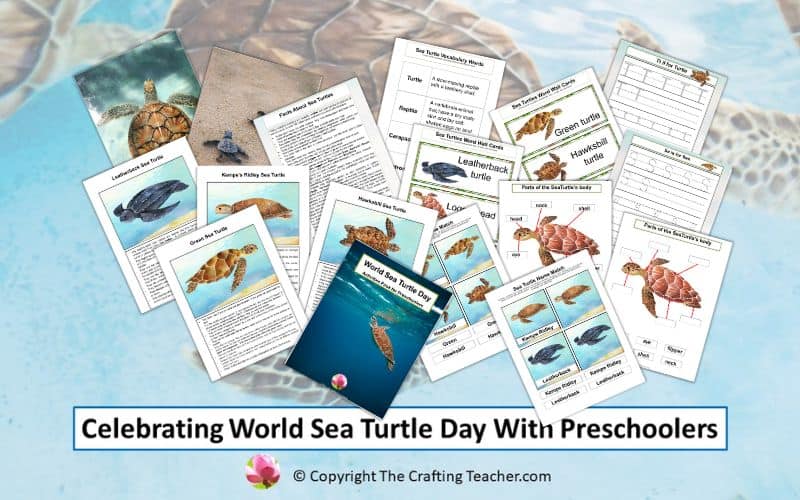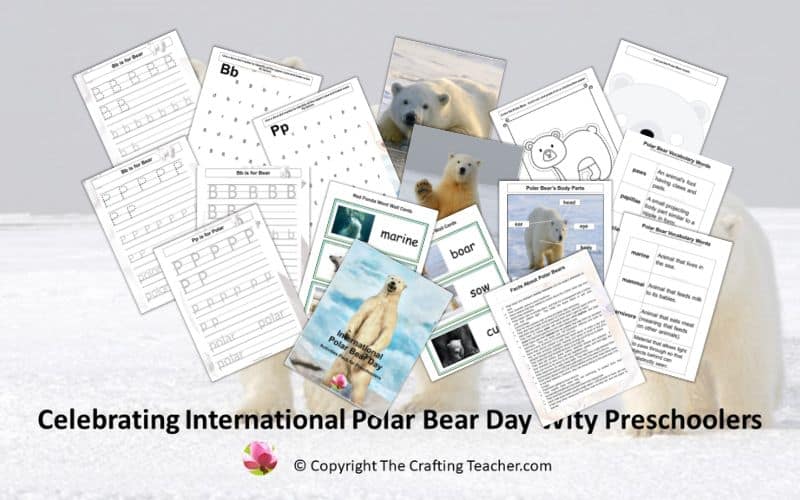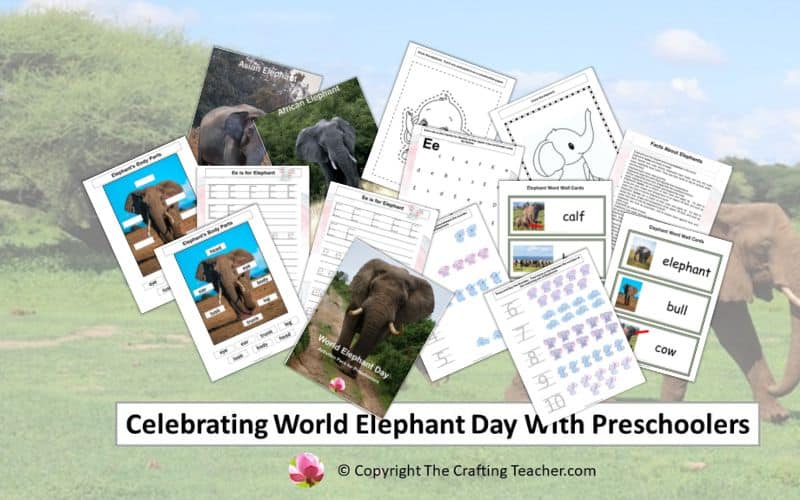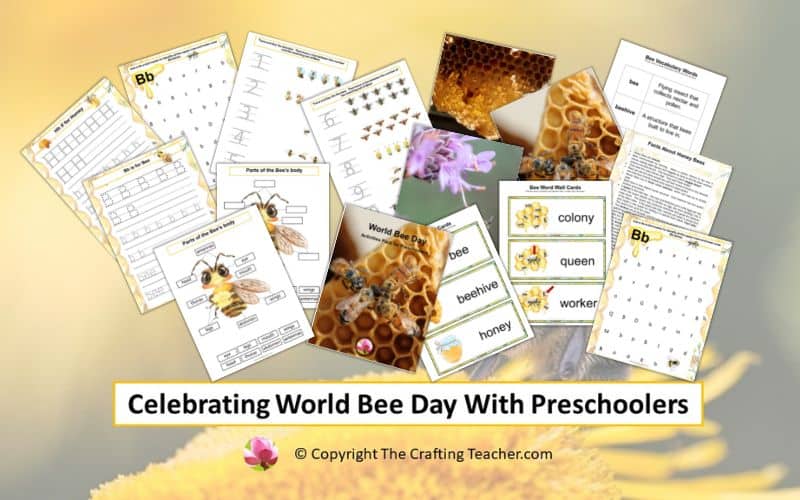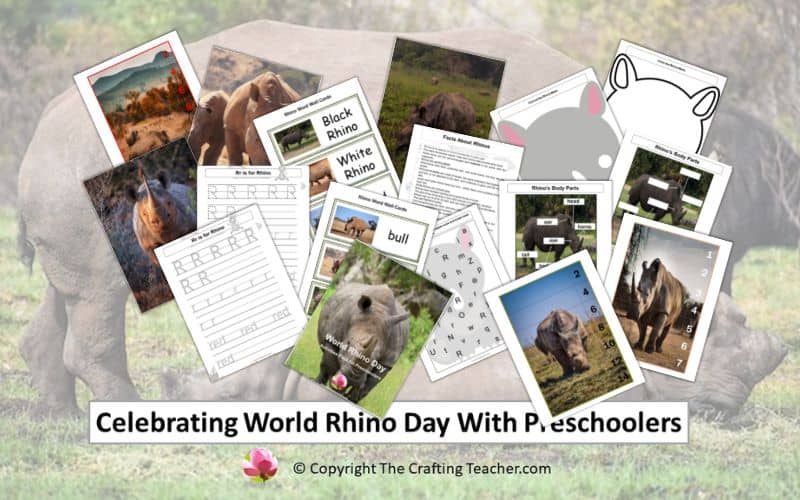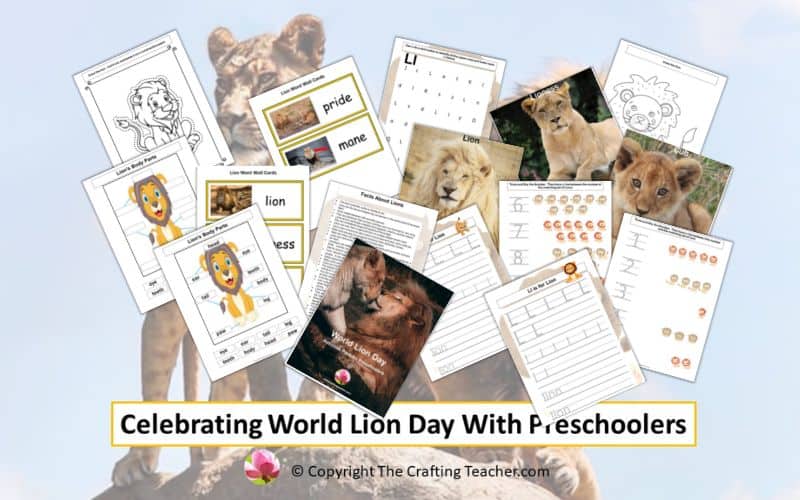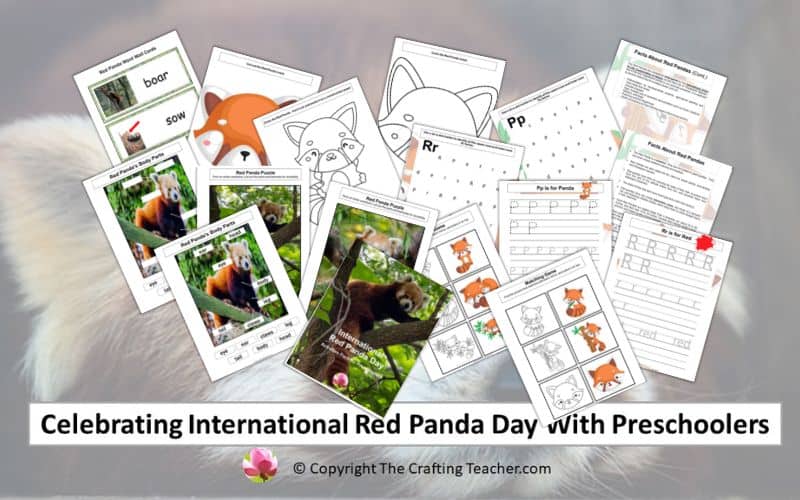Celebrating World Sea Turtle Day with Preschoolers
World Sea Turtle Day is celebrated every year on June 16 to raise awareness about the dangers that sea turtles are facing, to protect and educate these beautiful creatures, and to explain to the world why their conservation is critical for all living things.
Why? Because turtles are endangered or critically endangered, according to the International Union for the Conservation of Nature (IUCN) Red List. Six out of the seven marine turtle species are on the verge of extinction mainly due to:
- Destruction of habitats due to human development on nesting beaches limits the available space for nesting and blocks hatchlings’ paths to the sea.
- Plastic is dumped in our oceans (8 million tons every year, approximately). One of every two turtles confuses plastic littering the sea for jellyfish and getting killed when eating it.
- International turtle meat and eggs trade.
- Drowning after getting tangled up in fishing gear.
- Climate change increases the sand temperature alters the sea turtles’ sex ratios, causes the sea level to rise and flood the nests, and increases storms, which threatens the survival of the hatchlings.
The efforts that a lot of people, conservation programs, and organizations are making to protect sea turtles, and the laws put in place for this purpose are not enough. It is time that we get together worldwide and join the community’s efforts to save sea turtles. We, as preschoolers’ teachers and parents, must also take the time to inform and educate our children, hopefully promoting their love for these animals and the desire to protect and help them in the future.
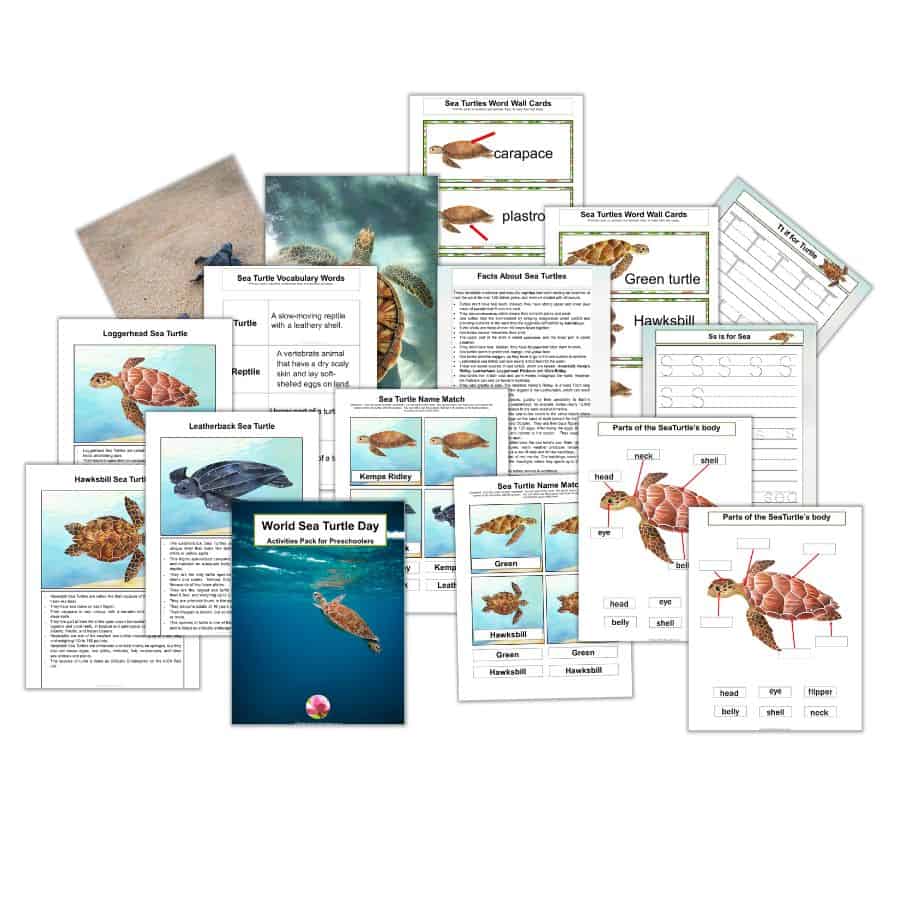
I’ve included a FREE 28-page long World Sea Turtle Day pack of activities for your preschoolers, which can be downloaded at the end of this post.
History of the World Sea Turtle Day
In 2000, June 16th was chosen by a conservation organization to honor the birthday of Dr. Archie Carr, a renowned sea turtle conservationist.
Dr. Archie Carr was a great biologist who dedicated his life to studying the ecology and behavior of sea turtles. With the support of the National Science Foundation, the Office of Naval Research, and the Sea Turtle Conservancy, he was able to perform the longest and most intensive studies of an animal population to date at Tortuguero National Park in Costa Rica, studying and tagging more than 35,000 adult female green turtles.
His research brought attention to the threatening conditions that continue to impact sea turtles today, which encouraged his students and other investigators to continue his efforts, creating a community that continues to strive for a better life and future for sea turtles around the globe.
Dr. Carr also founded the Sea Turtle Conservancy in Gainesville, Florida.
Facts About Sea Turtles
These incredible resilience and beautiful animals had been nesting on beaches all over the world for over 100 million years, and even co-existed with dinosaurs.
- Turtles don’t have real teeth. Instead, they have strong upper and lower jaws made of keratin that fit onto the skull.
- They are omnivorous, which means they eat both plants and meat.
- Sea turtles help the environment by keeping seagrasses under control and providing nutrients to the sand they the eggshells left behind by hatchlings.
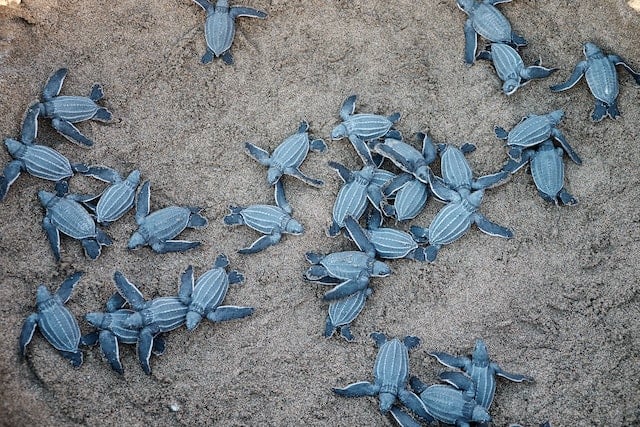
- Turtle shells are made of over 50 bones fused.
- Sea turtles cannot retreat into their shell.
- They don’t have feet. Instead, they have flippers that allow them to swim.
- Sea turtles seem to prefer red, orange, and yellow food.
- Sea turtles breathe oxygen, so they have to go to the sea surface to breathe.
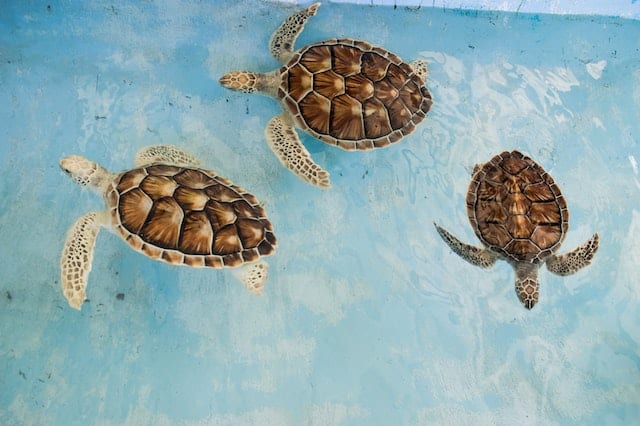
- Leatherback sea turtles can dive nearly 4,000 feet into the water.
- There are seven species of sea turtles, which are Green, Hawksbill, Kemp’s Ridley, Leatherback, Loggerhead, Flatback, and Olive Ridley.
- Sea turtles live in both cool and warm waters throughout the world. However, the Flatback can only be found in Australia.
- They vary greatly in size. The smallest, Kemp’s Ridley, is around 70cm long and up to 40kg in weight, and the biggest is the Leatherback, which can reach up to 180cm and 500kg in weight.
- They can migrate long distances, guided by their sensitivity to Earth’s magnetic fields. The female Leatherback, for example, swims nearly 13,000 miles over 647 days, from Indonesia to the west coast of America.
- Every two to three years female sea turtles return to the same beach where they hatched to lay their eggs on the sand at night (except for the Kemp’s Ridley turtle), between March and October. They use their back flippers to dig the nest hole and then lay up to 125 eggs. After laying the eggs, the turtle covers them to the nest site and returns to the ocean. They usually nest multiple times, about two weeks apart.
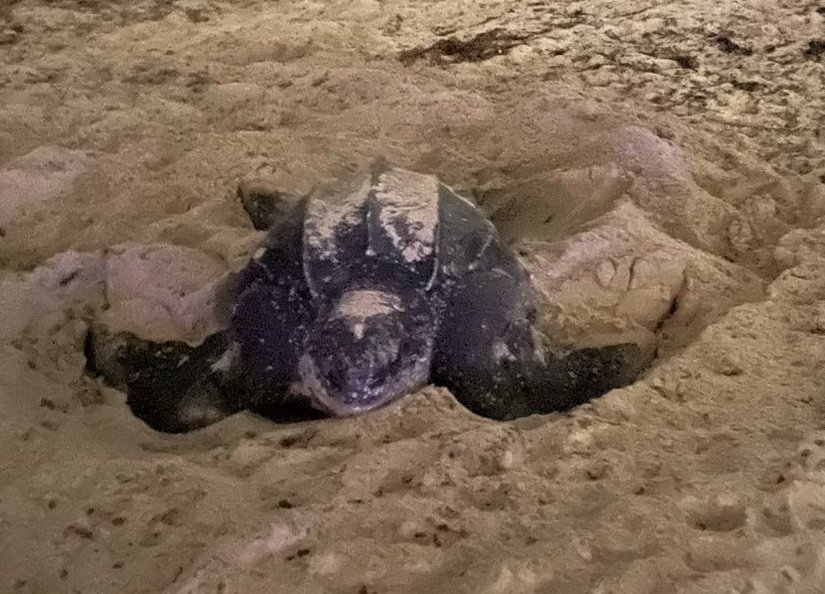
- The temperature of the nest determines the sea turtle’s sex. Male hatchlings are born in cooler temperatures, warm weather produces females, and fluctuating temperatures produce a mix of male and female hatchlings.
- Eggs hatch after an incubation of two months. The hatchings move towards the sea in the night following the moonlight, where they spend up to 20 years until they return to the coast.
- Unfortunately, only 1 in 1,000 sea turtles survive to adulthood.
- A large group of nesting sea turtles is called an “arribadas”, a Spanish word that means “arrival” in English.
- Sea turtles can live between 50 to 100 years.
Types of Sea Turtles
There are seven species of sea turtles, which are Green, Hawksbill, Kemp’s Ridley, Leatherback, Loggerhead, Flatback, and Olive Ridley.
Green Sea Turtles
- The Green Sea Turtle is called like that because of the green fat underneath its shell.
- It is the world’s largest species of hard-shelled turtles, and the second largest of all sea turtles, weighing around 143.3 – 286.6 pounds and measuring between 1-1.2 meters long, but when they are born, they are only two inches.
- They are found in tropical waters throughout the world, near coastlines.
- Their shell or carapace is shaped as a tear, and covers most of their body, except for their head and flippers.
- They can be underwater for up to five hours before they go up to the surface to breathe.
- When they are younger, they are omnivorous, eating worms, crabs, jellyfish, sponges, and aquatic insects, but they are adults they become completely herbivores and eat mostly algae and seagrasses. This diet is what gives them their green color.
- They are considered adults at 25 to 30 years old but, may not begin nesting until they are almost 40 years old.
- Scientists don’t know their lifespan but have observed some of them nesting for 38 years.
- Females Green Sea Turtles travel to their nesting beaches in over 80 different countries, every 2 to 5 years.
- Green Turtles are listed as critically endangered on the IUCN Red List.
Hawksbill Sea Turtles
- Hawksbill Sea Turtles are called like that because of their narrow head and hawk-like beak.
- They have two claws on each flipper.
- Their carapace is very unique, with a serrated look similar to a saw or steak knife.
- They live part of their life in the open ocean but spend more time in shallow lagoons and coral reefs, in tropical and subtropical coastline waters of the Atlantic, Pacific, and Indian Oceans.
- Hawksbills are one of the smallest sea turtles measuring up to 3 feet long and weighing 110 to 150 pounds.
- Hawksbill Sea Turtles are omnivores and feed mainly on sponges, but they also eat brown algae, sea jellies, mollusks, fish, crustaceans, and other sea animals and plants.
- This species of turtle is listed as Critically Endangered on the IUCN Red List.
Kemp’s Ridley Sea Turtles
- The Kemp’s Ridley Sea Turtle received this name in honor of Richard Kemp who helped to discover and study this species.
- They are only found around the Gulf of Mexico and juveniles along the east coast of the US and the Northwest Atlantic Ocean.
- Kemp’s Ridley Sea Turtles are the smallest sea turtles in the world, measuring only 24 to 27 inches long and weighing 100 pounds.
- They have powerful jaws that help them crush crabs, clams, mussels, and shrimp. They also like to eat fish, sea urchins, squid, and jellyfish.
- These turtles nest more often than other species, every 1 to 3 years on average.
- They are also the only species that nest in a mass called arribadas (Spanish for “arrival”).
- They lay an average of 110 eggs in each nest and the eggs incubate for about 55 days.
- These sea turtles may live 30 years and possibly up to 50 years.
- The Kemp’s Ridley Sea Turtles are considered critically endangered on the IUCN Red List.
Leatherback Sea Turtles
- The Leatherback Sea Turtles are named like that because of their unique shell that looks like leather. It is black, often speckled with white or yellow spots.
- This highly specialized carapace allows them to dive up to 4,000 feet, and maintain an adequate body temperature at these extremely cold depths.
- They are the only turtle species in the world that doesn’t have hard shells and scales. Instead, they have thin, rubbery skin hardened by thousands of tiny bone plates.
- They are the largest sea turtle species in the world, reaching more than 6 feet, and weighing up to 2,200 pounds.
- They are primarily found in the open ocean, all over the world.
- They become adults at 16 years old.
- Their lifespan is known, but scientists think they can live up to 50 years or more.
- This species of turtle is one of the most endangered creatures on Earth and is listed as critically endangered on the IUCN Red List.
Loggerhead Sea Turtles
- Loggerhead Sea Turtles are called like that because of their extremely big head, and strong jaws.
- Their heart-shaped shell or carapace is reddish-brown.
- Adult males are distinguished by long tails that extend beyond the rear carapace and a narrowing of the carapace that tapers towards the rear.
- Hatchlings have light to dark gray or brown shells. Their flippers are dark brown with white edges and their belly is a faded yellow.
- They are found in estuaries, coastal bays, and shallow waters along the continental Atlantic, Pacific, and Indian Oceans.
- The loggerhead is the most common sea turtle in the U. S. coastal waters.
- Loggerhead turtles are the largest of all hard-shelled turtles, reaching 3 feet long and weighing up to 250 pounds.
- They are carnivorous and eat clams, jellyfish, crabs, mussels, some types of fish, sea urchins, seaweed, and brown algae.
- Females become adults at 35 years old and nest every 2 to 4 years. They lay from 100 to 126 eggs in each nest, 12 to 14 days apart.
- Loggerhead Sea Turtles are listed as critically endangered on the IUCN Red List.
Flatback Sea Turtles
- The Flatback Sea Turtle is named after the relative flatness of its shell.
- It is the only sea turtle that doesn’t migrate and only lives in the coastal waters of Australia and Papua New Guinea.
- Females nest only on beaches in Australia, laying approximately 50 eggs each time.
- Hatchlings emerge from the sand, enter the water together, and stay closer to shore as they mature into adults.
- Flatback turtles eat jellyfish, sea cucumbers, and other invertebrates.
- The IUCN doesn’t have enough data to list the status of the Flatback Sea Turtle, but it is considered vulnerable in Australia. It is the least endangered of all of the sea turtles.
Olive Ridley Sea Turtles
- Olive Ridley Sea Turtles are named for the olive coloration of their heart-shaped shells when they are adults, but hatchlings are black with greenish sides.
- Their head is small, their carapace is bony without ridges, and have 1 or 2 claws on all their flippers.
- These are the smallest of all sea turtles reaching only 2 to 2.5 feet in length and weighing 77 to 100 pounds.
- They are omnivores and eat mollusks, shrimp, crabs, tunicates, fish, and sometimes algae.
- They are generally found in more than 80 countries, in coastal bays and estuaries, and in the tropical and subtropical waters of the Pacific, Indian, and Atlantic Oceans.
- They become adults at 13 years old.
- The Olive Ridley Sea Turtles are the only type of turtle that nest in synchronized large groups of more than several hundred turtles called arribadas (Spanish for “arrival”), two times each season, and lay over 110 eggs in each clutch.
- Even when they are the most abundant sea turtle species in the world, they are still, listed as Vulnerable, by the International Union for Conservation of Nature and Natural Resources.
How to Celebrate World Sea Turtle Day
There are many things you can do to celebrate World Sea Turtle Day but, most importantly because an active defender of these animals and teach your preschoolers and their families how to become one too. Some of the things I can mention are:
- Talk to your children about sea turtles, what is happening to them, and what will happen if we don’t do something about it.
- Sing turtle songs. Preschool Express has several fun ones. You can find them HERE.
- Go on a field trip to an aquarium or zoo to watch sea turtles, or invite your families to do it.
- Turn your sensory table into an egg-finding site by burying ping pong balls (turtle eggs) in the sand. You can write letters or numbers on the balls, and have your children tell what letter or number they dig out.
- Do turtle art crafts. You can find good ideas HERE.
- Organize a campaign to clean the beaches, and avoid turtles eating plastic and other types of trash, that suffocates them.
- Investigate which organizations and zoos have special events related to sea turtles, and participate with your children and their families.
- Stop using disposable water bottles, straws, plastic bags, and other similar items as much as possible to prevent plastic pollution even more, and be a voice about it and promote avoiding throwing plastic and other harmful items into rivers, lakes, seas, etc.
- Organize a fundraiser to collect funds to be donated to an organization that protects sea turtles.
- Invite your families and friends to adopt a sea turtle through the Marine Conservation Society, and do it yourself.
- Show your children videos that feature sea turtles. Below is a very good one from YouTube that you can use.
- Teach your children how to recycle, reuse and properly dispose of trash.
- Explain how to avoid disturbing nesting sea turtles and hatchlings, eliminate obstacles for the babies, and turn off the lights or use FWC-approved lights.
- Use your social media to spread awareness about this day and how to save sea turtles.
- Don’t buy items that come from sea turtles.
- Learn as much as you can about sea turtles, and teach others about them.
- Volunteer at organizations that protect and/or take care of sea turtles, and other endangered species.
Sea Turtle-related Books
Reading to your children about sea turtles is one of the best educational activities you can do to teach your kiddos about them, especially if you use books filled with amazing pictures and illustrations.
Many books address these amazing animals, both fictional and nonfictional. You can find books about these great birds at your local library, used book store, and on Amazon. I added my Amazon links to make it easier for you. Just click on the titles.
- Sea Turtles! by Hope Aicher. This engaging children’s book is brimming with stunning photos and fun facts about these ancient and magnificent creatures, to explore the lives of sea turtles, from the different types of species to their habitats and behaviors.
- Go Wild! Sea Turtles by Jill Esbaum. In this intro to the species, children discover where on Earth this reptile lives, what it eats, how big it grows, why sea turtles need our help, and what people around the world are doing to help save them.
- All About Animals – Sea Turtles by Tim Babler. This book has beautifully illustrated pages that bring the world of sea turtles to life, engaging and informative text that teaches children about different species of sea turtles and their habitats, and fun facts that capture their imagination and spark curiosity.
- National Geography Readers – Sea Turtles by Laura Marsh. Kids will learn all about these tranquil and mysterious animals through brilliant photography and illustrations, plus trusted and distinctive content.
- Sea Turtles by Gail Gibbons. With colorful, clear illustrations and straightforward text, the author introduces the eight kinds of sea turtles living in the ocean today and teaches the similarities and differences with labeled diagrams with detailed illustrations.
- Sea Turtles by Tristan Walters. This book is perfect for children who have a passion for learning about wildlife and a special interest in these mysterious ocean creatures.
- Good Night Turtles by Adam Gamble. This charming and educational book gives children a peek into the fascinating world of turtles, including habitat, species identification, green turtles, loggerheads, kemp’s Ridley’s, box turtles, snapping turtles, tortoises, soft shell and hard shell turtles, mud turtles, pond turtles and more.
Pin It for Later
If you are in a rush and don’t have time to read the post and download the printable but want to save it for later, pin it to one of your Pinterest boards for later.
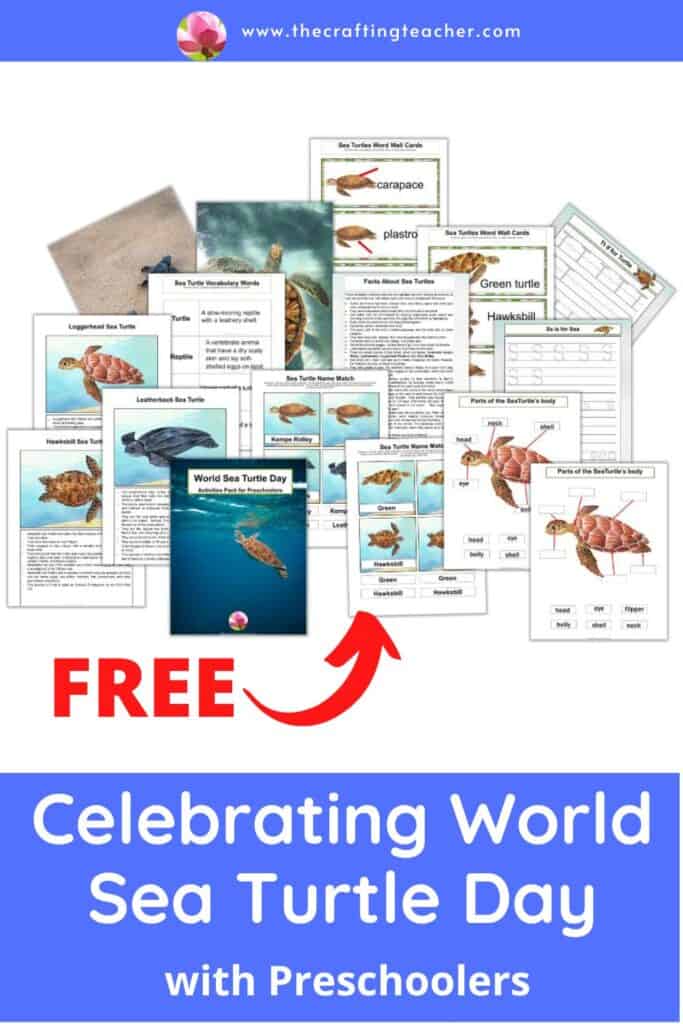
We must talk to our children about sea turtles, and encourage them to love and support these animals, so they can become protectors and advocates, to avoid their extinction.
I hope you enjoy these ideas and help you have fun during the World Sea Turtle Day celebration with your preschoolers. To get the FREE pack, you just have to click on the link below and put your information, for an immediate download.
Be happy, safe, and creative. I wish you well.
Love,

P.D. Please let me know if you like these ideas or if there’s anything I can help you with.

